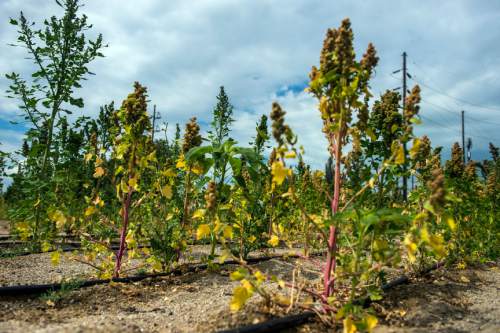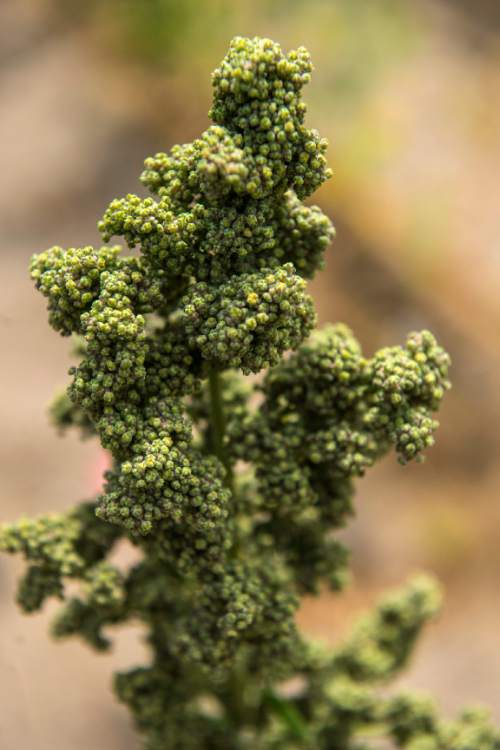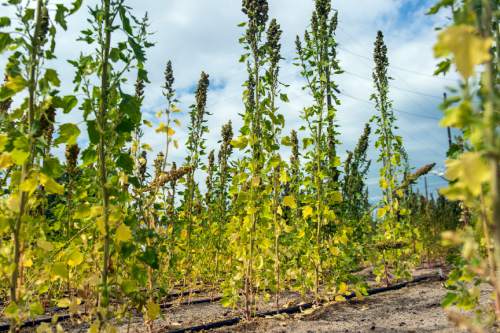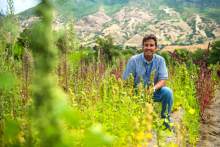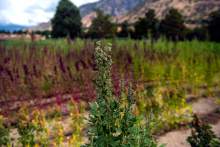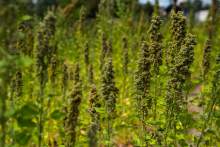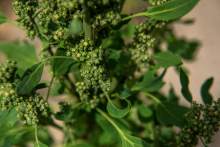This is an archived article that was published on sltrib.com in 2014, and information in the article may be outdated. It is provided only for personal research purposes and may not be reprinted.
Provo • Behind an apartment complex across the street from Brigham Young University, there's a small field that, come mid-July, explodes with green, red, purple and orange stalks of quinoa, a plant whose grain-like seeds have recently appeared on the plates of health-conscious diners worldwide.
Domesticated on the Altiplano, a high arid plain mostly encompassed by Bolivia, quinoa (pronounced keen-wä) is one of the few foods that can provide all the nutrition one needs to survive, according to those who study it. If you could choose one food to have with you on a desert island, quinoa could be it.
Researcher Rick Jellen and his colleagues say their breeding program at BYU is a step toward making quinoa a viable option for feeding a hungry and sometimes malnourished world.
"Religiously, I see this as a resource that God has given to all of his children, to benefit all of his children, not just one nation," Jellen said while walking through his quinoa field last summer.
But their work — and other international efforts to make quinoa cheaper and more available — may also erode the food sovereignty of Andean countries. Bolivia, Peru and others fear their farmers and residents could be priced out of raising and eating the traditional crop as other nations reap the economic fruits of the quinoa boom.
These countries carefully protect access to seeds from the thousands of varieties of quinoa they own, worried about the implications of researchers elsewhere developing a plant that thrives outside the Altiplano.
That's exactly what BYU, working with scientists at Utah State, Oregon State and Washington State universities, hopes to do.
—
'Food is a human inheritance' • Much of quinoa's appeal comes from its seemingly incredible properties. It's high in the essential amino acids humans need to live, unlike, for example, durum wheat, which is deficient in lysine.
Quinoa can also grow in salty soil — so salty that it's possible to irrigate a crop with salt water, according to Jellen. That makes it an attractive prospect for farming on marginal lands where other crops would fail.
Its leaves are edible, nutritious and taste like spinach, Jellen says. The seeds can vary from the familiar grain-like variety to a version that's more like sticky rice.
"That opens up a whole new door of value-added types of things," Jellen said — think quinoa sushi.
These qualities have piqued the interest of people who are fighting international malnutrition or hunger.
"It gets me in trouble, but the reality is in 50 years, or what's going to be the end of this century, there's going to be another five billion people on this planet, and you've got to feed them," said BYU professor Jeff Maughan, who is also Jellen's brother-in-law. "So when I start thinking about food, food is a human inheritance."
Decades ago, farmers in Bolivia and Peru faced low demand, according to researchers. "When we started working on quinoa, we were trying to rescue [it], because it looked like it was on the road to extinction as a crop," Jellen said.
Quinoa research began at BYU in the late 1980s after Dan Fairbanks, formerly at BYU and now dean of the College of Science and Health at Utah Valley University, noticed the plant's potential. Early work on quinoa was backed by the Ezra Taft Benson Institute, a research foundation that aims to raise the quality of life of the world's poor.
Later, with funding from the McKnight Foundation, BYU researchers partnered with PROINPA, the independent Foundation for Investigation and Promotion of Andean Products.
Bolivian scientists at PROINPA continued to develop quinoa through farming, improved its processing, promoted it at local fairs and collected recipes that might have been lost, Fairbanks said.
Using publicly available quinoa seeds and genetic material temporarily loaned by Bolivia, BYU scientists focused on genetic work that couldn't be done in that country.
—
Who owns quinoa? • BYU hoped Bolivia would eventually more freely share seeds from the roughly 5,000 varieties of quinoa it owns, which would help the university breed improved varieties.
Without access to genetic diversity, it's hard to identify which types of quinoa might do well outside the Altiplano. Plant quinoa in, say, Utah, and it becomes vulnerable to pests and viruses not seen in the Andes.
Quinoa is hardy, able to dump salt from soil into its leaves rather than into parts that would make it inedible or kill other plants. But cultivating domesticated varieties in different locales doesn't always produce the same large, tasty seeds; heat may prevent seeds from forming, or the yield might be much lower.
Wild quinoa grows throughout the United States, along roads in Los Angeles and the Frontrunner line in Salt Lake City, but its seeds are small and bitter.
Today, Bolivia still has never shared seed stocks with BYU. It has a long history of wariness, and controversy with Colorado State University in the 1990s likely cemented its stance.
Using seeds that activists argued were stolen from the Altiplano, CSU patented a "mutant cytoplasm" that could provide more control over quinoa breeding.
After an outcry from ecological justice advocates and ANAPQUI, the Bolivian National Association of Quinoa Farmers, CSU dropped the patent. Plant geneticist Sarah Ward, who discovered the cytoplasm, said it was dropped because CSU couldn't find anyone interested in using it commercially.
"During the years I worked with quinoa, I also heard many angry comments from Ecuadorean and Peruvian quinoa breeders and agronomists about how the Bolivians think they own quinoa, and that others have no right to develop or exploit the crop," Ward said.
Jellen calls that idea "ridiculous," comparing it to Iran or Syria claiming a kind of ownership over the world's wheat supply because wheat was domesticated in that region thousands of years ago.
"I understand that from a cultural standpoint, and I understand that you want to protect that," Maughan said, "but I also think that we need to be careful and say, 'Wait a minute, those people are coming and they deserve to be fed, just like you and I.' "
But when wheat — and in another example, potatoes, indigenous to Peru and now ubiquitous worldwide — began to be traded, modern economies and patent law didn't exist, Fairbanks acknowledges.
"The economics of it are very different," he said. "Nobody was acquiring patents on new genetic varieties [of plants in general] up until probably the 1980s."
Quinoa, he added, "became a worldwide food during the lifetimes of the people who were originally growing it."
—
Cost and benefit • BYU researchers see Andean countries' reluctance to share seeds as an impediment to both research and improving the crop.
"Quinoa is bigger than Bolivia," said BYU researcher Joshua Udall. "Other countries use it, Argentinians are domesticating it, Canadians are now, and the Bolivians are just going to get left behind."
Commercial production is underway in both Western Australia and the United Kingdom, according to The Guardian and Australian media. Small farms are growing quinoa in the U.S.
Utah State researcher Jennifer Reeve believes there's a better option than blocking access — sharing seeds with conditions.
"I would argue it would actually be in their benefit to release [seeds] in a controlled manner with those requirements in place, with, perhaps, royalties attached to anything that was developed," she said.
Bolivian officials did not respond to several requests for comment.
Still, some potential problems are clear. Increased production outside the region could drive prices down, hurting Andean exports, especially among top producers such as Peru and Bolivia.
On the other hand, lower prices could drive farmers and Andean residents to eat more quinoa, rather than exporting it and buying less nutritious foods.
Today's high prices can pressure producers to aggressively plant quinoa, rather than rotating crops or resting their fields, which can damage the land.
Pat Mooney, who worked with Bolivian farmers opposing the CSU patent, said he recognizes that quinoa will eventually be grown commercially outside the Altiplano. But the development needs to occur legally, he said.
And quinoa developers should realize their work will have profound effects, said Mooney, now executive director of ETC Group.
"There should be a moral recognition that very poor farmers in the Andes have this crop as an important source of income," he said, "and if that's about to be disrupted in a dramatic way, at the very least, they should be given as much advance warning as possible."
—
The future of quinoa • As quinoa is grown internationally, Bolivian farmers will have options, said PROINPA geneticist Alejandro Bonifacio, He's been a partner in BYU's work since the beginning and completed his doctorate at BYU under Fairbanks.
Bolivians may focus on promoting the quality of the large-seeded "real" (Spanish for "royal") variety that only grows in the Altiplano, he said in emails sent from rural Bolivia, where he was working during planting season.
They could focus on organic farming and marketing products as gluten-free, he added.
Bonifacio's main concern for quinoa is its sustainability during climate change. He hopes to combine indigenous knowledge with modern science and technology to ensure its future.
At BYU, scientists have federal funding to evaluate plants bred at Washington State for commercial viability, and to collect wild domestic quinoa. They're also running an early breeding program.
Researchers stressed that they're not looking for a discovery to patent. They're instead focusing on mixing things up, genetically speaking — crossing varieties and seeing how they grow.
"We want to see how various materials behave in our environment," Jellen said. "How do they look? What's the seed yield like?"
They expect to share the plants they create, but Jellen said he doesn't rule out a patent in the future.
"Say we do find something in these preliminary nurseries, we find something that's really, really good... then Jeff and I might say, 'Let's push for a commercial variety release and see if BYU will back us up on that,' so that we can get a little bit of revenue to support our research."
And support is key. Despite the rise in demand, Jellen calls quinoa an "orphan crop," not seen as important enough to attract money for study and improvement, like corn and wheat.
"There isn't much funding at all out there for domestication of new crops or introduction of new crops in the U.S.," said Udall, the BYU researcher.
Maughan said BYU is also in the early stages of applying for a grant to map the entire quinoa genome.
They're also interested in other foods that, like quinoa, are relatively obscure but have enormous potential. Right now, they're finishing up sequencing the genome of amaranth.
"Go into Bolivia, walk into a farmer's field," Maughan said. "There's a lot of cool stuff that Americans don't know about, Europeans don't know about, and we don't want to lose."






